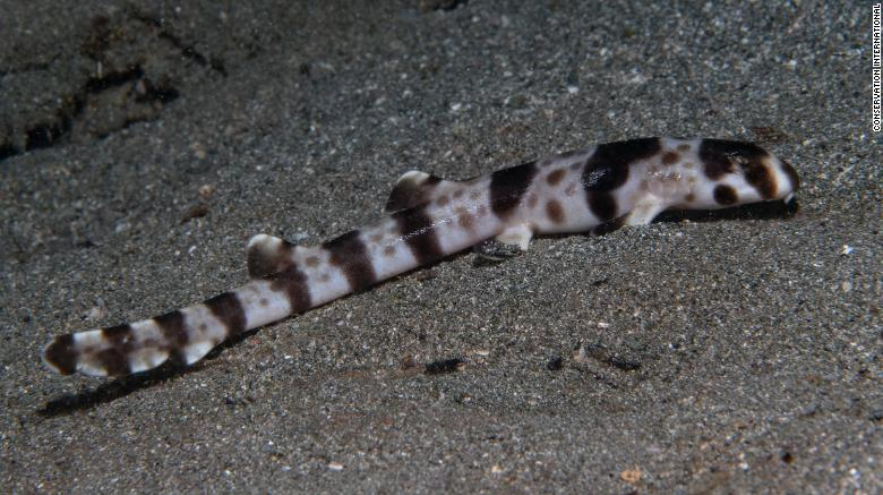Tag: shark
Scientists discovered four new species of sharks that walk
So — some sharks walk. Just not the scary ones. While great whites haunt the deep, walking sharks are content to scuttle in the shallows.
They’ve been walking, or something close to it, for at least 9 million years. They’re evolutionary superstars, too: Walking sharks could be the most recently evolved shark on Earth. That’s according to findings published this week in Marine and Freshwater Research.
Shark scientists spent years sampling the DNA of the only known walking shark species to estimate when they evolved. They found four new species while they were at it.
The youngest species might’ve evolved less than 2 million years ago. And by evolutionary standards, that’s recent — and a major contradiction to the widely held belief that sharks are slow to evolve. “The discovery proves that modern sharks have remarkable evolutionary staying power and the ability to adapt to environmental changes,” said Mark Erdmann, the paper’s co-author and Conservation International Vice President of Asia-Pacific marine programs. Sharks are older than dinosaurs, dominating the seas for as long as 400 million years (the oldest dinosaur fossil is thought to be about 240 million years old, by comparison). So the fact that sharks continue to evolve as recently as 399 million years later is pretty remarkable.
How they walk and where they do it

Walking sharks, also called “epaulette” sharks for their spots that resemble the military decor, “walk” on their muscular fins to forage for small fish along shallow reefs and sea grass. It’s a behavior partially driven by changing sea levels and shifting landscapes, which ultimately influenced where most of the nine known species settled — eastern Indonesia and neighboring islands, New Guinea and parts of Australia. Based on differences in the sharks’ DNA, scientists created estimated evolutionary timelines. They found walking sharks started to split off from their evolutionary relatives around 9 million years ago.
This walking shark, which resides in a shallow ocean off New Guinea, uses his fins to “walk” along the sea floor in search of food. During mass extinction events, carpet sharks, the group that includes walking sharks, were among the “most affected” animals, researchers wrote. Sea levels rose and ocean temperatures dropped, pushing the sharks to migrate to warmer waters. Sharks off the coast of Australia “hitched a ride” on moving tectonic plates all the way to New Guinea, researchers said. When the plates stopped shifting, the land settled, creating barriers for species to migrate. This might be why the sharks’ habitat rarely overlap, they wrote.
Hope for walking sharks’ future
Erdman said the group hopes their research could encourage conservationists to add a few of the sharks to the IUCN Red List, a global inventory of threatened species, based on how little is known about them. “A global recognition of the need to protect walking sharks will help ensure they thrive providing benefits for marine ecosystems and to local communities through the sharks’ value as tourism assets,” he said. “It’s essential that local communities, governments and the international public continue working to establish marine protected areas to help ensure our ocean’s biodiversity continues to flourish.”
Article via CNN
Shark attacks California Instagram model in Bahamas
“I am so fortunate that I still have my arm and my life.”
Katarina Zarutskie was floating calmly in the ocean off the Bahamas’ Staniel Cay when she suddenly felt her arm being yanked down.
Zarutskie, a 19-year-old nursing student and Instagram model from Laguna Beach, California, had been swimming with nurse sharks when one bit her arm and started to drag her under the water last month. Her boyfriend’s father took several photos throughout the attack, capturing the exact moment that Zarutskie came in contact with the 5-foot-long shark.
“He had my wrist in his mouth and I could feel his teeth sinking into my arm,” Zarutskie told NBC News on Monday. “I was pulled underwater for a few seconds and then ripped my wrist out of the shark’s mouth as fast as I could.”
When she got free of the shark’s bite, she swam to some steps — holding her bleeding arm out of the water to not tempt more sharks — and got out of the ocean.
Zarutskie, who attends the University of Miami, had been on vacation with her boyfriend and his family and had heard from locals that swimming with nurse sharks was a fun and safe activity. She did not swim with the sharks through a tour company or any organization that required payment, but, having grown up as a surfer in Southern California, she said she was not afraid to jump in the water near a marina.
“My boyfriend’s family was freaking out when I went to swim with the sharks and I was like, ‘it’s fine,'” she said.
According to David Hocher, who owns Staniel Cay marina, people do get bitten from time to time while around the sharks.
“These animals are considered quite docile but can and do bite on occasion,” Hocher wrote in an email. “Normally when they mistake a hand or fingers for a piece of food.”
Hocher sent NBC News a picture of a sign at the marina that warns guests that nurse sharks “can and do bite” and that visitors must “swim with the sharks at your own risk” — but Zarutskie said she did not see the sign.
Read more via: Shark attacks California Instagram model in Bahamas



